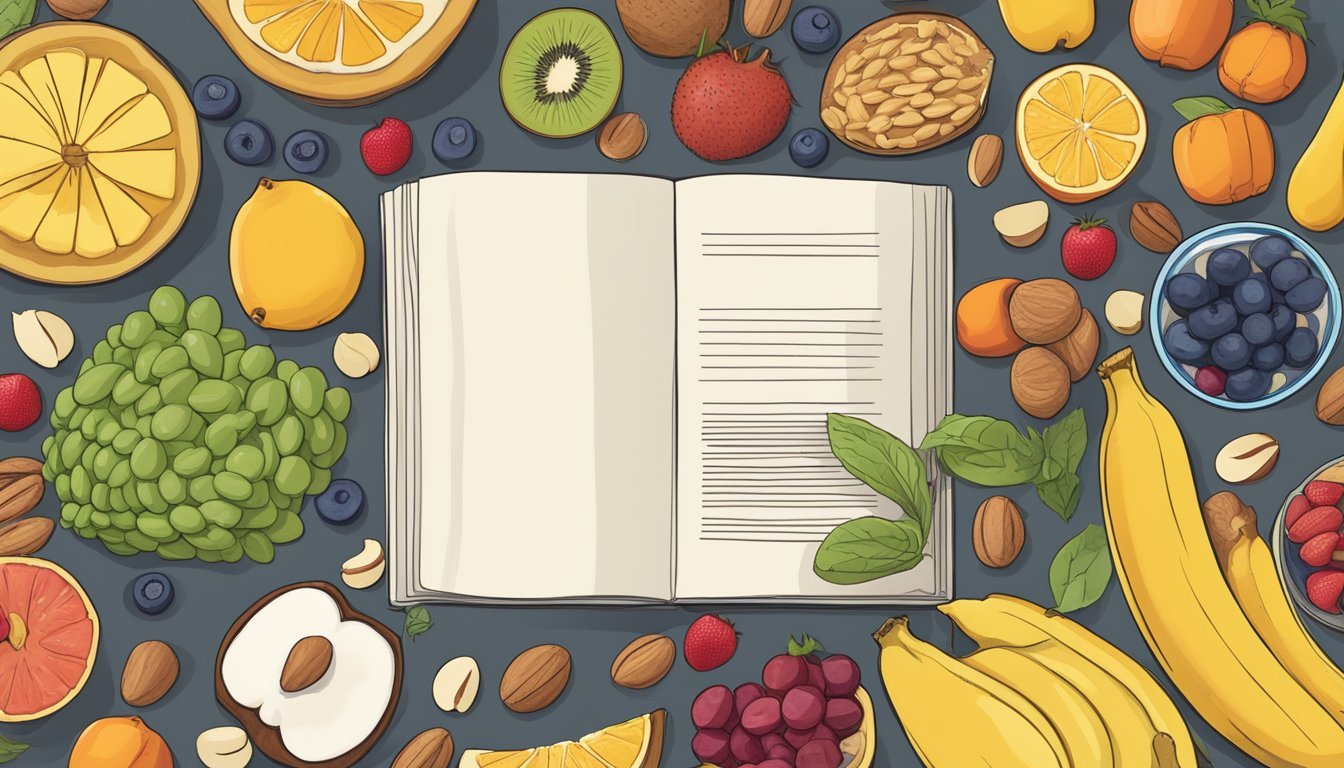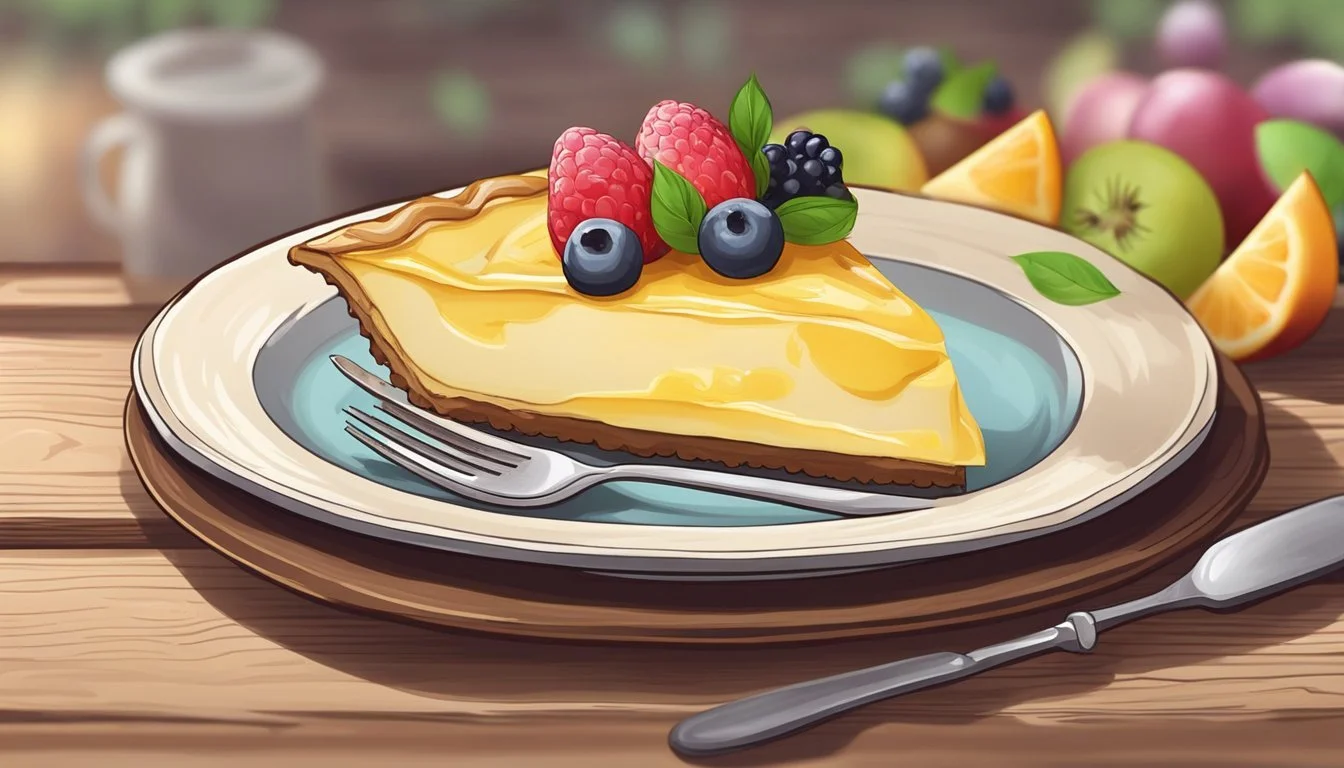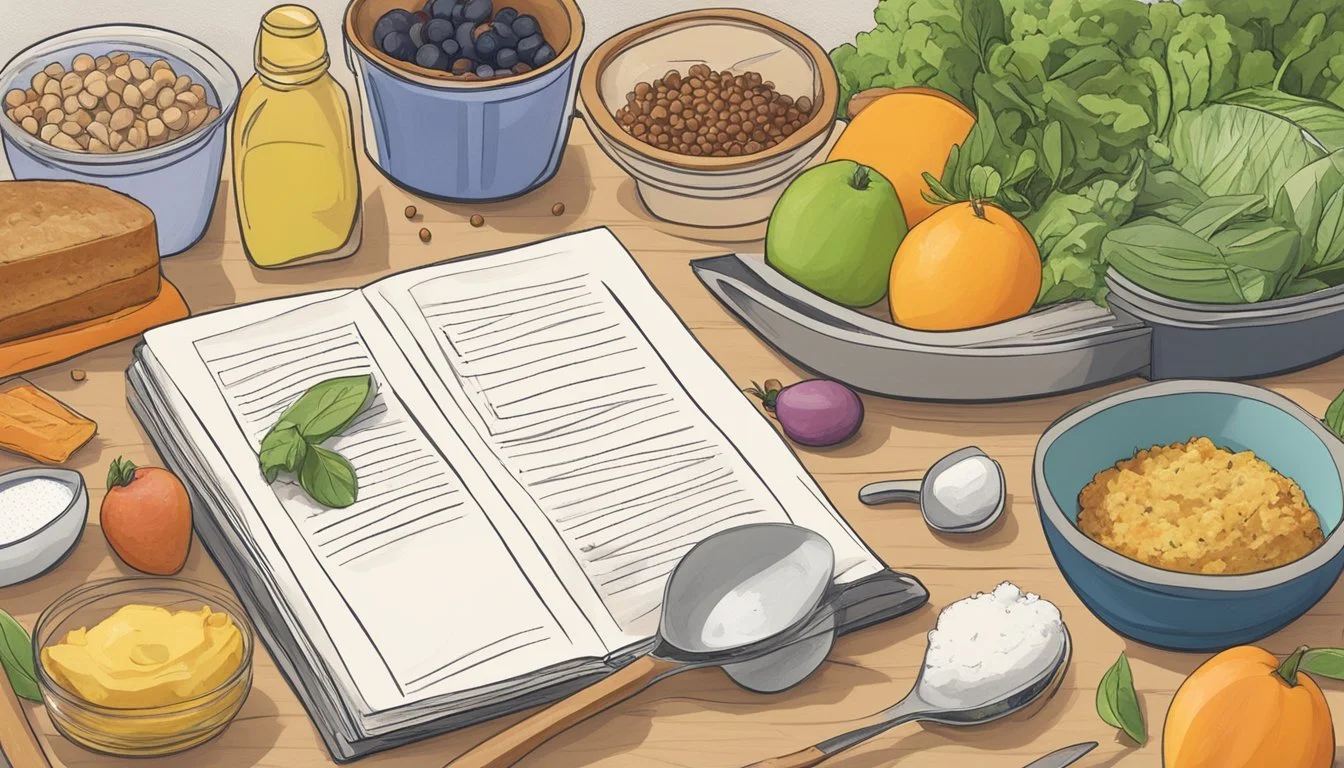Is Nesselrode Pie Vegan?
Unveiling the Ingredients and Options
Nesselrode pie, a culinary relic of New York's mid-20th century dessert scene, has piqued the interest of contemporary food enthusiasts and historians alike. Characterized by its rich filling made from chestnut puree, and traditionally made with a custard that includes milk, cream, egg yolks, and gelatin, the pie also often features a variety of fruits and nuts. Given the ingredients involved in its preparation, Nesselrode pie would not be classified as vegan due to the presence of animal-derived products such as dairy and eggs which are fundamental components of the custard base.
The pie's resurgence raises questions about its compatibility with modern dietary preferences, particularly veganism. Many desserts (What wine goes well with desserts?) have been adapted to fit vegan diets by substituting plant-based alternatives for animal-derived ingredients. However, the challenge in veganizing Nesselrode pie lies in replicating the specific textures and flavors that the original animal-based ingredients impart. The chestnut custard, a hallmark of the pie, would need careful consideration to maintain the dessert's integrity while ensuring that all components are free from animal products.
Adhering to a vegan diet involves avoiding all animal products, which extends to the kitchen where items like gelatin—an animal-derived gelling agent commonly used in Nesselrode pie—are replaced with plant-based alternatives such as agar-agar or pectin. The process of transforming traditional recipes to fit these dietary constraints often requires creativity and experimentation with ingredients to retain the dish's essence.
Historical Origins of Nesselrode Pie
Nesselrode pie is a rich dessert that has its origins in the 19th century and was once a staple in New York City eateries.
Influence of Count Karl Nesselrode
The dessert takes its name from Count Karl Nesselrode, a Russian diplomat, known for negotiating the Treaty of Paris. It is believed to be inspired by a series of desserts, particularly puddings, favored by Nesselrode himself. The common element is chestnut, an ingredient frequently associated with his name.
Popularity in New York City
In New York City, the Nesselrode pie became a celebrated dessert, especially around the holidays. Dubbed as the "Cronut of 1946," its popularity rose to the point where it was commonly featured on dessert menus and Christmas tables in the mid-1900s. Establishments like the Brownstone Restaurant contributed to its widespread recognition.
Hortense Spier and the New York Times
The pie was further popularized through exposure in the New York Times. A particular mention is attributed to Hortense Spier, who discovered the recipe within the archives of the New York Public Library. Her exploration into old New York cuisines brought the pie back into light, cementing its place in New York's food history.
Key Ingredients
The key ingredients in a traditional Nesselrode pie are crucial to its unique flavor profile and texture. This section examines the components responsible for the pie's characteristic taste.
Chestnut Puree and Custard
Traditionally, Nesselrode pie includes a chestnut puree base blended within a rich custard. The custard is typically made using heavy cream and sugar, infused with vanilla for flavor, and then combined with a puree of chestnuts to create a smooth and creamy texture.
Chestnut Puree: Made from boiled and pureed chestnuts, sweetened with sugar.
Custard Ingredients:
Heavy cream
Sugar
Vanilla extract
Use of Gelatin and Eggs
To achieve its firm yet delicate consistency, Nesselrode pie often incorporates gelatin and eggs.
Gelatin: A setting agent derived from animal collagen.
Eggs: Used both as a binder and for enriching the custard base.
Note: The traditional use of gelatin and eggs disqualifies this dessert as vegan unless substitutes are used.
Fruits and Flavors
Fruits and additional flavors are layered into Nesselrode pie to enhance its complexity and sweetness.
Fruit Ingredients:
Maraschino cherries
Candied orange peel
Chocolate: Often grated as a garnish on top.
Additional Flavors:
Egg whites: Sometimes used to create a lighter, airy texture in the filling.
Sugar: Essential for sweetness, often balanced with the tartness of fruit.
Vegan Considerations
When examining the traditional Nesselrode pie recipe, one must consider its reliance on non-vegan ingredients requiring suitable replacements for a vegan version.
Animal-Based Ingredients
The original Nesselrode pie is not vegan-friendly as it contains several animal-based ingredients:
Milk: Often used as the base for the custard filling.
Egg yolks: Integral for thickening the custard and adding richness.
Unflavored gelatin: Typically utilized for setting the pie's texture.
Whipped cream: Frequently used as a topping and for adding creamy texture.
Vegan Ingredient Alternatives
To adapt the Nesselrode pie for a vegan diet, one must find alternatives that can emulate the characteristics of these animal-based ingredients:
Milk: Plant-based milks such as almond, soy, or coconut milk can be used as one-to-one substitutes.
Egg yolks: To replace the thickening property of egg yolks, one could use cornstarch or arrowroot powder mixed with water.
Unflavored gelatin: A common vegan substitute is agar-agar, which is derived from seaweed and sets similarly to gelatin.
Whipped cream: Vegan whipped creams are available, often made from coconut cream or aquafaba (the liquid from canned chickpeas).
By thoughtfully selecting alternatives, one can recreate the lush texture and rich flavor profile of the Nesselrode pie while ensuring it adheres to a vegan diet.
Preparing Nesselrode Pie
The preparation of Nesselrode Pie involves crafting a flavorful crust, creating a rich custard filling, and careful assembly followed by refrigeration to create this decadent dessert.
Creating the Pie Crust
One begins with the pie crust, which is foundational to the texture and taste of Nesselrode Pie. Traditionally, a flaky and rich pecan crust suits this dessert well. The pecans are usually ground finely in a food processor for a consistent texture and then combined with flour, sugar, and butter. After forming the dough, one presses it into a pie tin and bakes until golden.
Key Steps:
Grind pecans finely using a food processor.
Combine with flour, sugar, and butter.
Bake the crust until it is a golden color.
Making the Custard Filling
For the custard filling, a key component of the recipe begins with macerating certain ingredients, such as chestnuts, which are fundamental to the flavor profile. The preparation continues with mixing in sugar, eggs, and potentially gelatin, which will thicken the mixture as it cooks. One diligently stirs the mixture in a saucepan, monitoring with a thermometer to reach the ideal consistency when the custard reaches 180 degrees. Once achieved, they transfer the custard to a mixing bowl to halt the cooking process.
Key Steps:
Macerate flavoring ingredients, like chestnuts.
Mix sugar, eggs, and gelatin; cook and stir until reaching 180 degrees.
Transfer to a mixing bowl to prevent further cooking.
Assembly and Refrigeration
Assembling the pie requires layering the cooled crust with the rich chilled custard, ensuring the distribution is smooth and even. For a quintessential finish, they might whip cream until it forms soft peaks to top the pie, creating an aesthetically pleasing and palatable texture contrast. The final step is to refrigerate the pie, allowing it to set properly so that it maintains its structure and texture when served.
Key Steps:
Layer the custard into the cooled crust.
Optionally top with whipped cream until soft peaks form.
Refrigerate to set the pie before serving.
Decorative Elements and Serving
Nesselrode pie's presentation is elevated by its decorative toppings and serving style. These enhancements not only add visual appeal but also contribute to the overall taste and texture of the dessert.
Meringue and Whipped Cream Toppings
Traditional Nesselrode pie is often adorned with a topping of meringue or freshly whipped cream. The meringue provides a sweet, light contrast to the rich filling, typically piped onto the pie in peaks or spreads evenly for a smooth finish. For whipped cream, one would generously dollop or artfully swirl it atop the pie just before serving. Some recipes suggest incorporating a tablespoon of liqueur into the whipped cream for additional flavor depth.
Garnishing with Chocolate and Fruit
Shaved chocolate and fruit are common garnishes that add both texture and eye-catching details to Nesselrode pie. To make chocolate shavings, one uses a vegetable peeler or knife to create delicate curls from a bar of high-quality chocolate. These shavings are sprinkled over the whipped cream for a sophisticated touch. Moreover, macerated cherries—cherries that have been soaked in liqueur or a sugar solution—provide a juicy, indulgent element when placed elegantly atop or alongside the pie.
Cultural and Modern Significance
Nesselrode Pie, once a staple on New York's dessert menus during the mid-20th century, particularly around Christmastime, has experienced a decline in popularity. However, there have been recent efforts to bring this holiday dessert back into the limelight, highlighting its unique taste and place in New York's culinary heritage.
Nesselrode Pie in Modern Dessert Culture
The Nesselrode pie is not a common sight in today's dessert scene. As a holiday dessert that peaked in mid-20th century New York, it has largely fallen out of the modern palate's favor. Its complex flavors, which defy the simplistic tendencies of current dessert trends, are reminiscent of a bygone era. Despite its scarcity, it remains a part of New York’s rich culinary history and an emblematic dish that captures the essence of New York’s diverse taste preferences during the holiday season.
Revival of Nesselrode Pie by Petee’s Pie Company
Petee’s Pie Company, a New York bakery on the Lower East Side, has been at the forefront of resurrecting Nesselrode pie. Owned by Petra and Robert Paredez, the bakery is known for its commitment to pie-making that honors New York's food history. Petra Paredez, the head baker, intentionally chose to replace the traditional candied fruits with black rum-soaked cherries, offering a modern twist to Petee’s Nesselrode pie. This move, while maintaining the integrity of the original recipe, appeals to the contemporary New York palate and serves as a touch of innovation, bringing a forgotten dessert back to life and into modern dessert culture.
Variations of Nesselrode Pie
In exploring the diverse world of Nesselrode pie, one finds regional tweaks and dietary customizations that transform this classic dessert. These variations cater to local tastes and specific dietary needs while maintaining the dessert’s signature profile.
Regional and Seasonal Variations
The traditional Nesselrode pie, known for its rich chestnut flavor, often sees regional influences in its preparation. In some areas, fruit such as lemon or banana cream may be blended into the filling for a citrusy twist or a more tropical essence. Seasonal adaptations include the introduction of pumpkin during fall festivities, folding the earthy squash into the custard to celebrate the harvest.
Other alternatives feature unique ingredients like luxardo, a cherry liqueur, which is used to imbue the pie with a deeper, more nuanced fruit note. This ingredient is sometimes more prevalent in areas with a predilection for fruit-based desserts. (What wine goes well with fruit-based desserts?)
Dietary Adaptations such as Vegan or Gluten-Free Options
The classic Nesselrode pie is made with components like egg yolks and whole milk, which are not suitable for vegans. However, inventive adaptations have been crafted to meet these dietary preferences:
Egg Replacement: Vegan versions might substitute the egg-based custard of a traditional Nesselrode pie with a coconut custard. Coconut milk and cream can replicate the texture and richness typically provided by eggs and dairy.
Dairy Alternatives: Almond or soy milk can successfully replace whole milk, and dairy-free whipped toppings can be used in place of cream.
For those avoiding gluten, a gluten-free crust can be constructed using ingredients such as almond flour or crushed gluten-free biscuits, ensuring the pie is accessible to those with wheat sensitivities.
It is noteworthy that while these adaptations may modify the Nesselrode pie’s traditional composition, the fundamental purpose of creating a delicious, creamy dessert remains the focal point of these variations.
Recipes and Cooking Tips
When preparing Nesselrode pie, a traditional dessert with a blend of chestnut puree and spiked with rum, precision in following steps and temperature measurements is crucial for the desired quality and texture.
Step-by-Step Nesselrode Pie Recipe
Chestnut Custard Preparation: Begin by chilling a mixing bowl. Combine sugar, salt, and gelatin in a saucepan. Whisk in egg yolks followed by chestnut puree. Gradually whisk in the cream and milk, cooking over moderate heat.
Custard Cooking: Look for the custard to thicken and reach the crucial temperature of 180 degrees on a candy thermometer. Once thickened, remove from heat immediately to prevent overcooking.
Mixing and Flavors: Transfer the custard to the chilled bowl. Add macerated cherries and rum for flavor. The mixture should be stirred until consistent throughout.
Meringue Preparation: Beat egg whites until they form stiff peaks, gradually adding sugar to form a glossy meringue. Fold this gently into the chestnut mixture.
Assembly: Pour the combined mixtures into a pie crust and chill until set. For added luxury, a layer of chocolate ganache can be spread on the crust before adding the filling.
Troubleshooting Common Issues
Custard Consistency: If the custard is too thin, ensure that it reaches the correct temperature with precise measurement using a candy thermometer. If it's too thick, it may have been overcooked.
Meringue Challenges: For stiff peaks, make sure the bowl and beaters are completely free of grease, and that no yolk is mixed with the whites.
Flavor Balance: If the pie lacks depth, adjust the quantity of rum or add more macerated cherries to enhance the taste.
The key to a perfect Nesselrode pie lies in the delicate balance of textures from the chiffon-like filling to the crisp crust, complemented by the flavors of roasted chestnuts and rum. This refined confection, reminiscent of the bustling 1940s Brooklyn, requires patience and attention to detail to replicate a classic piece of New York's culinary history.
Conclusion
Nesselrode pie traditionally includes ingredients that are not vegan, such as cream and, potentially, glaceed fruits which may contain animal-derived gelatin. The classic recipe necessitates cream to create soft peaks for decoration and may sometimes include liqueur. Since cream is a dairy product, it disqualifies Nesselrode pie from being vegan.
For individuals adhering to a vegan diet, it is crucial to be aware that unless explicitly stated, it should be assumed that Nesselrode pie is not suitable for vegans. However, vegan substitutions can be made. Dairy cream, for instance, could be replaced with coconut cream or another plant-based alternative. Similarly, any gelatin in the glazed fruit can be swapped with vegan gel options.
In conclusion, one must be mindful of the original ingredients comprising Nesselrode pie and seek vegan-labeled variations or adapt recipes accordingly to fit a vegan diet. It is thus essential for those interested in a vegan version to undertake a careful examination of ingredients or to consult directly with the baker or manufacturer. With the necessary adaptations, it is possible to enjoy a Nesselrode pie that aligns with vegan principles, albeit with a thoughtful revision of its traditional counterparts.
References and Resources
To assess whether Nesselrode pie is vegan, individuals need to review the traditional ingredients and preparation methods. The key resources for this investigation include historical recipes, contemporary adaptations, and culinary articles detailing the pie's composition.
Primary Ingredients:
Chestnut puree
Rum or brandy
Whipped cream
Chocolate shavings
Candied fruits
Relevant Cookbooks and Historical Texts:
Historical New York City baking texts
Period cookbooks with dessert sections
Online Resources:
Petee’s Pie Company: For contemporary takes on the recipe
New York Times Cooking: A reputable source for a variety of recipes, including Nesselrode pie adaptations.
For Vegan Alternatives:
Vegetarian and vegan cooking blogs: They may explore plant-based substitutes for the pie’s dairy and alcohol components.
Vegan baking cookbooks: These often present methods for replacing non-vegan ingredients like cream and gelatin.
Culinary Articles:
Articles that examine the history and cultural significance of Nesselrode pie.
Discussions on the pie’s components and why it was particularly popular in New York.
Researchers and enthusiasts alike should verify that the resources are trustworthy and up-to-date. It's essential to compare multiple sources when looking for vegan alternatives to ensure that the substitutes align with vegan dietary restrictions.











